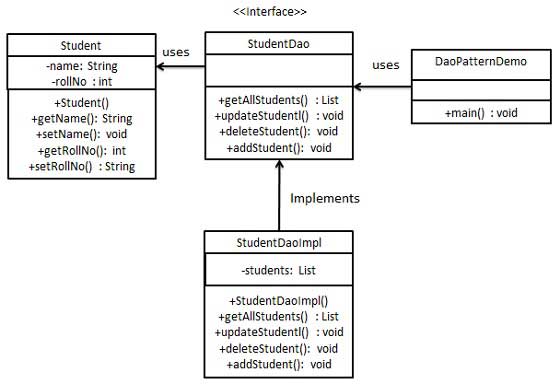Data Access Object Pattern or DAO pattern is used to separate low
level data accessing API or operations from high level business
services. Following are the participants in Data Access Object Pattern.

Student.java
StudentDao.java
StudentDaoImpl.java
DaoPatternDemo.java
- Data Access Object Interface - This interface defines the standard operations to be performed on a model object(s).
- Data Access Object concrete class - This class implements above interface. This class is responsible to get data from a data source which can be database / xml or any other storage mechanism.
- Model Object or Value Object - This object is simple POJO containing get/set methods to store data retrieved using DAO class.
Implementation
We are going to create a Student object acting as a Model or Value Object.StudentDao is Data Access Object Interface.StudentDaoImpl is concrete class implementing Data Access Object Interface. DaoPatternDemo, our demo class, will use StudentDao to demonstrate the use of Data Access Object pattern.
Step 1
Create Value Object.Student.java
public class Student { private String name; private int rollNo; Student(String name, int rollNo){ this.name = name; this.rollNo = rollNo; } public String getName() { return name; } public void setName(String name) { this.name = name; } public int getRollNo() { return rollNo; } public void setRollNo(int rollNo) { this.rollNo = rollNo; } }
Step 2
Create Data Access Object Interface.StudentDao.java
import java.util.List; public interface StudentDao { public List<Student> getAllStudents(); public Student getStudent(int rollNo); public void updateStudent(Student student); public void deleteStudent(Student student); }
Step 3
Create concrete class implementing above interface.StudentDaoImpl.java
import java.util.ArrayList; import java.util.List; public class StudentDaoImpl implements StudentDao { //list is working as a database List<Student> students; public StudentDaoImpl(){ students = new ArrayList<Student>(); Student student1 = new Student("Robert",0); Student student2 = new Student("John",1); students.add(student1); students.add(student2); } @Override public void deleteStudent(Student student) { students.remove(student.getRollNo()); System.out.println("Student: Roll No " + student.getRollNo() + ", deleted from database"); } //retrive list of students from the database @Override public List<Student> getAllStudents() { return students; } @Override public Student getStudent(int rollNo) { return students.get(rollNo); } @Override public void updateStudent(Student student) { students.get(student.getRollNo()).setName(student.getName()); System.out.println("Student: Roll No " + student.getRollNo() + ", updated in the database"); } }
Step 4
Use the StudentDao to demonstrate Data Access Object pattern usage.DaoPatternDemo.java
public class DaoPatternDemo { public static void main(String[] args) { StudentDao studentDao = new StudentDaoImpl(); //print all students for (Student student : studentDao.getAllStudents()) { System.out.println("Student: [RollNo : " + student.getRollNo() + ", Name : " + student.getName() + " ]"); } //update student Student student =studentDao.getAllStudents().get(0); student.setName("Michael"); studentDao.updateStudent(student); //get the student studentDao.getStudent(0); System.out.println("Student: [RollNo : " + student.getRollNo() + ", Name : " + student.getName() + " ]"); } }
Step 5
Verify the output.Student: [RollNo : 0, Name : Robert ] Student: [RollNo : 1, Name : John ] Student: Roll No 0, updated in the database Student: [RollNo : 0, Name : Michael ]

No comments:
Post a Comment